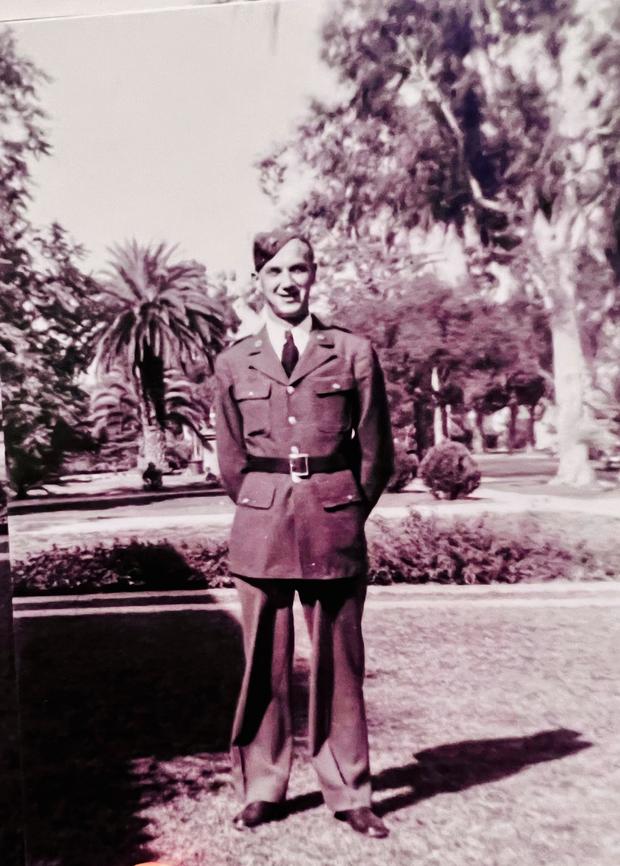
One family lost 2 sons during WWII. It took 80 years to bring the last soldier home.
Elsie Thompson, the youngest of seven children, lost two brothers during World War II. Her sibling Phillip Engesser was returned home to be laid to rest, but her oldest brother, Marcus Engesser, is only just being brought back to his California hometown more than 80 years after his death thanks to an identification by the Defense POW/MIA Accounting Agency.
Engesser served in Company L of the 31st Infantry Regiment during World War II, operating in the Philippines. He was captured following the American surrender of the Bataan Peninsula in April 1942, the DPAA said, and forced on the Bataan death march before being interned in a notorious prison camp. He died of malaria in September 1942 and his remains were buried in a mass grave at the camp. Over 2,800 American soldiers died at the camp before its liberation in 1945, the agency said.
Defense POW/MIA Accounting Agency
In 1947, that grave was exhumed and the U.S. Army attempted to identify the soldiers buried there. At the time, most of the remains were considered unidentifiable, and they were buried at the Manila American Cemetery and Memorial as Unknowns. Engesser’s name was engraved on the Walls of the Missing at the cemetery.
North Korea. The diplomacy is even small-scale enough to connect with individual locals, Wright said, since sometimes a fallen soldier may have vanished on what is now private land.
Korean War POW identified, buried near fellow vet and friend
04:49
Once the DPAA researchers have determined they’re in the right spot, a recovery mission is sent to the area. These teams of 15 to 25 people, Wright said, included explosive ordnance disposal experts who can handle live ammunition that may be on the scene. Medical personnel, senior recovery experts and forensic photographers are also part of these groups, and up to 100 locals may be involved with the physical work of digging and searching for remains. Recovery missions spend 30 to 60 days on the ground, Wright said, before returning to the DPAA laboratory.
Back at the lab, multiple scientific techniques are used to try and identify fallen soldiers. Forensic odontologists, or dentists who can look at medical records and compare them to teeth found in the field, can match dental evidence to the profiles of missing soldiers. Other unique bones, like clavicles, are compared. For soldiers who disappeared during the Korean War, experts compare tuberculosis skin test results taken before someone shipped out to the remains found.
The remains are then laid out and X-rayed to be matched further, other forms of analysis include mitochondrial DNA analysis and isotope analysis, which can determine what a person was eating decades ago. This can help identify the remains of American soldiers – who typically ate a corn-based diet – from the remains of locals who may have eaten differently. The DPAA has also collected comparison DNA from family members, like Thompson.
Once a fallen soldier has been likely identified, family members are asked for a reference sample of DNA. Finally, a medical examiner will sign off on a report making the identification, and service casualty officers then reach out to family members for a full briefing.
The process is painstaking and long. Families can spend decades wondering what happened to their loved one, Wright said, like Thompson did.
“Every case is different and faces its own challenges, and every case is special,” Wright said. “Every single one of these cases has a family member. Every single one of those has a comrade-in-arms who still wonders what happened to them. That number is definitely not lost on us in any way, shape or form.”
Defense Department/William Dasher
Bringing closure to families
Wright said that the DPAA’s goal is to bring closure to family members and loved ones like Thompson and Smith. Once family members are told about the identification of their loved one, the military works with the families to conduct a burial with full military honors.
“Even if we just find and make an identification of a single tooth, they will get full military honors because they made that ultimate sacrifice,” Wright said.
Smith said that having this closure has been “amazing” for her family and said she is honored that her uncle will receive a full military funeral. She said that she and Thompson would be able to meet the plane bringing Engesser’s remains to California on the tarmac. They also received Engesser’s medals.
“My grandmother went through so much … After all these years, to have it full circle, to have (Engesser) come home and be buried with his mom, it just means a lot,” Smith said. “I’m so thankful that my mom was alive to see this happen. I know it means a lot to her to have her brother back on American soil.”
Kerry Breen
Source: cbsnews.com
